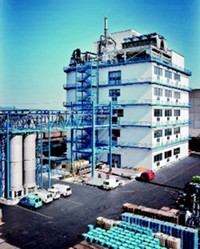Advertisement
Grab your lab coat. Let's get started
Welcome!
Welcome!
Create an account below to get 6 C&EN articles per month, receive newsletters and more - all free.
It seems this is your first time logging in online. Please enter the following information to continue.
As an ACS member you automatically get access to this site. All we need is few more details to create your reading experience.
Not you? Sign in with a different account.
Not you? Sign in with a different account.
ERROR 1
ERROR 1
ERROR 2
ERROR 2
ERROR 2
ERROR 2
ERROR 2
Password and Confirm password must match.
If you have an ACS member number, please enter it here so we can link this account to your membership. (optional)
ERROR 2
ACS values your privacy. By submitting your information, you are gaining access to C&EN and subscribing to our weekly newsletter. We use the information you provide to make your reading experience better, and we will never sell your data to third party members.
Business
Finding Pcas
French fine chemicals firm hopes to show up on pharma industry radar after a wave of acquisitions
by RICK MULLIN, C&EN NORTHEAST NEWS BUREAU
January 24, 2005
| A version of this story appeared in
Volume 83, Issue 4
A weekday morning cab ride from the center of Paris to the headquarters of Produits Chimiques Auxiliaires et de Synthése (PCAS) in the suburban town of Longjumeau is pure culture shock. Setting out from the grand boulevards, a visitor ends up an hour later lost in a hazy landscape of highways, strip malls, gas stations, and industrial parks--something like Houston, but with smaller cars.
Not that PCAS would desire an elegant Parisian address to enhance some kind of Gallic image. One of a handful of fine chemicals firms operating in France, the company has traditionally done more than 60% of its business in the U.S. and elsewhere in Europe.
Founded in 1962, PCAS has become a mid-tier contender in the global active pharmaceutical ingredients (API) market, with 2004 sales of about $260 million. Last year, it set up its first full-time U.S. sales operation in another hotbed of highways and strip malls, New Jersey.
But Paris taxi drivers are not the only ones who shrug their shoulders when they hear the name PCAS. According to Chief Executive Officer Christian Moretti, the firm, despite its world-market ambitions, does not get the recognition it deserves for its custom manufacturing capabilities or for one of its key technological strengths, chiral chemistry.
PCAS started an aggressive growth campaign 12 years ago when it began shifting its focus from specialty chemicals to pharmaceutical fine chemicals. This followed a decade of being bought and sold by major specialty chemical companies, including Stauffer Chemical, Unilever, ICI, and Akzo Nobel.
In 1992, Dynaction, a Paris holding company, financed a management buyout, enabling PCAS to begin its transformation into fine chemicals under then-CEO Jean-Pierre Stephan. Dynaction currently holds 70% of the company, and most of the rest of PCAS shares are traded on the Paris Stock Exchange.
PCAS has taken advantage of downsizing in manufacturing among French pharmaceutical companies and among its key contract customers in France and elsewhere. In 1998, PCAS purchased both Seloc, a former Marion Merrill Dow API facility owned by Schwarz Pharma in Limay, and Pharmacie Centrale de France, a metal oxides and specialty salts maker with a pharmaceutical final dose and packaging business in La Voulte sur Rhone, France.
In 2001, the company purchased Expansia, the API manufacturing wing of Beaufor Ipsen, in Aramon, France. It also took a 50% stake in Leiras Fine Chemicals, a division of Schering AG, in Turku, Finland. Last year, PCAS acquired the other half of the Turku operation, for a total investment of $20 million, and took an 85% stake in an Aventis API facility near Paris, an investment of $21 million.
PCAS purchased its first North American operation, Quebec-based St-Jean Photochemicals, which manufactures electronic chemicals. PCAS also acquired a 50% interest in E-Pharma, a finished dosage unit of Johnson & Johnson, in 2001.
Stephan succeeded in doubling sales between 1996 and 2000, reaching $108 million. He vowed to do it again over a shorter period of time, and he did so with the purchase of Expansia and Leiras.
By 2002, the company could claim that pharmaceutical synthesis and dosage form activity accounts for nearly 60% of sales. In addition, it had amassed a debt of $77 million, which prompted an announcement that further acquisitions would be placed on hold.
Last year, under its new CEO, the company got back on the acquisition trail with the Aventis deal. Moretti also consolidated the finished dosage activities to form Crèapharm Developpement and established PCAS's stake in the Aventis plant as VLG Chem, a subsidiary with small-scale current Good Manufacturing Practice (cGMP)-certified production that will cater to emerging drug companies.
The VLG site consists of two plants, one of which is dedicated to producing the API for an Aventis blockbuster, according to Moretti. The company has a six-year supply contract with Aventis worth $40 million per year and is hoping to increase its business with the drugmaker. "We expect them to come to us with new business as products come up," Moretti says. "We want to be their short-list supplier."
In the meantime, PCAS is hoping to build new relationships at VLG with biotech companies. "We will work hard to cover biotech by selling them research," Moretti says. "If the clients are successful with new molecules, they will remember us. We are optimistic that gratitude exists."
With VLG focusing on research-oriented early-stage work, the company hopes to increase the efficiency of its other sites in the commercial API market. "Big pharma's push now is for cost reduction," says Vincent Touraille, department manager of pharma synthesis at PCAS. "Aramon and Limay are for big projects."
Through its acquisitions, the company has also amassed a portfolio of technologies, including chiral chemistry, cytotoxic and enzymatic reactions, and drug formulation.
PCAS's rapid growth, however, has not shielded it from the recent downturn in custom manufacturing. Moretti admits that 2003 was a bad year for the company's pharmaceutical business--sales dropped by $13 million, he says, sending total sales to $250 million.
Part of the rebound in 2004, he says, is attributed to the acquisition of the Aventis facility and the sale of a vestigial specialty operation. VLG is expected to add $40 million in revenue in 2005. Overall, Moretti anticipates a 15% rise in sales this year to almost $300 million.
Michel Follet, scientific director for pharma synthesis, sees acquisitions on hold for now. "First of all, we have to breathe," he says. "In 1995, PCAS was 300 people. Ten years later, PCAS is 1,500 people. We have to digest the acquisitions and reorganize everything."
The general idea, Follet says, is to align assets into a full-service company supplying everything "from the first gram to the final dose form." Ideally, the pharmaceutical business will be split evenly between generic APIs, production for partners such as Aventis, and custom synthesis. ?
Industry analysts say the odds are tough for companies like PCAS that grow rapidly through acquisition, especially by buying drug companies' unwanted assets. "Just buying stuff is not the answer," says Howard J. Foote, president of Meadowbrook Associates, a consulting firm in Sturgeon Bay, Wis. "There is a lot of junk out there, and pharmaceutical fine chemicals is an increasingly competitive business."
He notes that nearly 1,200 companies were at the CPhI trade show in Brussels last month, "and there were a lot of people walking around. I don't know if there is enough activity to keep all of them busy." Others note that PCAS has amassed assets that will have a hard time competing with low-cost Asian producers.
However, James R. Bruno, director of Chemical & Pharmaceutical Solutions, Hamilton Square, N.J., says PCAS has managed the risks of growth well. "PCAS a few years ago was a traditional chemical company with not a lot to offer, mostly what we would call dirty chemistry," Bruno says. "They have successfully, via acquisition, gotten into a lot of interesting technology. There isn't much overlap."
Joseph Tessier, vice president in charge of marketing in the new U.S. PCAS office in Hoboken, N.J., says PCAS's period of rampant acquisition was "definitely a concern" when he left Summit Pharmaceuticals to take the job last year. But he is convinced that PCAS is successfully executing a workable plan of coordinating activities at several sites. He says the company's technology expertise is a bulwark against Asia for now, but that the firm will have to look toward partnerships or even an Asian acquisition.
He admits that a big part of his job now is selling that story to drug companies. "In going around and visiting the major pharmaceutical companies, I find that people are aware of the name PCAS, but they aren't at all aware of the breadth of capabilities we have," he says. "That has been my job--bringing everybody up to date about the new PCAS."
TEAMING UP
PCAS And The Professor Wrestle Polymorphism
In 1995, researchers at PCAS's laboratories in Limay, France, ran into a problem while working on a chiral drug ingredient. "The molecule was becoming more and more complicated," says Gérard Guillamot, the firm's director of R&D. "We saw many polymorphs in the crystalline form, and we needed support." He contacted Gérard Coquerel, a chemistry professor at the nearby University of Rouen.
Thus began a 10-year collaboration focused on polymorphism and crystallization in chiral chemistry. The partners, who are still working on the molecule that brought them together--pleconaril, ViroPharma's antiviral drug--have developed broad expertise in the area. As a result, PCAS claims to have carved a distinct niche in the competitive field of chiral active pharmaceutical ingredients.
According to Guillamot and Coquerel, the university-industry linkup, which now involves a PCAS researcher working part time toward a Ph.D. at the university, was forged at a time when such collaborations went against the grain.
"Universities like their prerogatives and don't like to be attached to industry by money or anything else," Guillamot says. But the group at Rouen broke the mold. "Coquerel was completely open to collaboration with industry," he says, partly because the most interesting work on polymorphism was emerging from industrial labs.
Coquerel sees the partnership with PCAS as a significant early example of the kind of relationships that are becoming more popular in France. According to Coquerel, 10 of the 15 Ph.D. candidates currently in his laboratory are sponsored by drug companies. Guillamot says PCAS now collaborates with nine universities.
Both Guillamot and Coquerel see a new generation of young college professors behind the shift in attitudes. They say academic research heads now recognize that they can bolster their know-how by working with cutting-edge industry labs. They also recognize that, with cuts in state funding, financial support from industry is not such a bad thing.
Coquerel says the relationship has also helped promote graduate work in chemistry by illustrating a clear career path for Ph.D. chemists.
Perhaps the biggest challenge for collaborating universities, Coquerel says, is maintaining the balance between fundamental and applied research. "If in the end I do only applied research," he says, "I am giving myself away and betraying the spirit of the university."








Join the conversation
Contact the reporter
Submit a Letter to the Editor for publication
Engage with us on Twitter